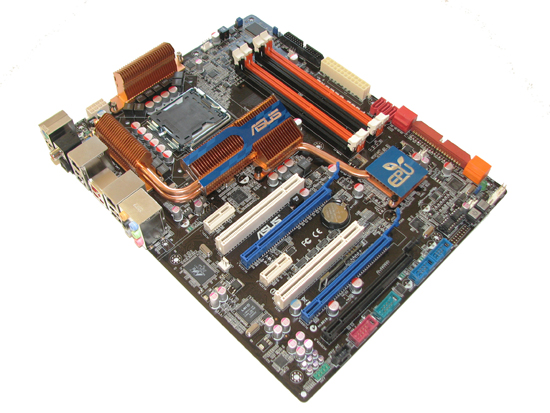
Original Link: https://www.anandtech.com/show/2525
ASUS P5Q3 Deluxe: An Early Preview of P45 Express Performance
by Kris Boughton on May 13, 2008 2:00 PM EST- Posted in
- Motherboards
As one of the motherboard industry's most experienced advocates of new technology, ASUS wasted no time in preparing what may be their premier Intel P45-based offering, the P5Q3 Deluxe, for near global distribution. With the long-awaited first-round availability of motherboards based on Intel's newest high-performance X48 Express chipset barely behind us, some buyers are finding themselves at yet another crossroad. This time attention is focused squarely on P45, Intel's first ever consumer chipset built using 65nm process technology. Today, choosing the right platform can be a lot like trying to take aim at a field of continually moving targets: just when you think you've figured out what's right for your next build the market shifts and something new appears on the not-too-distant horizon. As before, this has a lot of users asking if now is the right time to pick up that board they've been eyeing or if they would be better off waiting just a little while longer for the next big thing to come down the pipe.
In the past, most new chipset launches either were well timed to coincide with the release of a new system-wide feature/technology or were introduced due to the need to support the validated operation of an entirely new CPU architecture. The Intel P45 Express chipset will continue to defy this pattern, the seemingly lockstep association of CPUs and chipsets having been abandoned long ago. Intel ditched the single chipset approach awhile back giving rise to what can only be described as the continual overlapping availability of multiple chipset models at any given time. The idea is that each design is tuned for a specific market sector, with default behavior depending on the intended application and with support for certain minimum requirements. Of course, this also provides an easy way to differentiate product offerings based on the target performance segment, thereby allowing top-shelf prices for premium components.
Ultimately, all of this goes back to our initial entering argument - should I wait or should I go? With Intel's next-generation Nehalem CPU architecture due to arrive sometime in late 2008 or early 2009, P45 will offer users one last chance to upgrade before the monolithic MCH design goes the way of the dodo. As the last of its kind, P45 must be capable of standing the test of time. Given the maturity of the ICH/MCH design, we expect P45 to be very capable, and the adoption rate among OEMs should be especially high. However, it remains to be seen whether P45 will be the crowning glory of the pre-IMC (Integrated Memory Controller) chipsets, or if it will merely be the last gasp from a dying breed.
From a feature perspective, P45 brings little if anything new to the table. To our surprise, unlike X48, P45 will not boast official support for Intel's newest 1600 FSB (400 MHz) CPUs, such as the Core 2 Extreme QX9770 quad-core processor, officially topping out at 1333 FSB. The chipset has been validated for operation at up to DDR3-1333 only, with as much as 8GB of non-ECC main system memory. However, designs utilizing DDR2 will be able to make use of as much as 16GB of memory but will be limited to a maximum memory speed of DDR2-1066, unless the chipset is overclocked. Assuming inexpensive 8GB DDR2 kits (2x4GB) ever appear on the market, P45 could be quite the platform for those that are looking to run 64-bit OSes that can employ such massive amounts of installed memory.
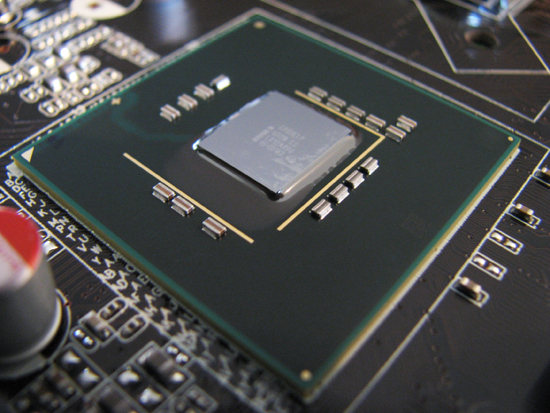 The Intel P45 Express chipset, seen here as a revision A2 chip, is quite a bit larger than we expected. |
In addition, P45 provides full PCI Express (PCIe) 2.0 interconnect compliance, which increases the maximum theoretical bandwidth of any installed PCIe 2.0-enabled component by twofold. However, unlike X48, P45 only provides 16 PCIe 2.0 lanes, so AMD/ATI CrossFire setups will only receive half the bandwidth relative to an X38/X48 board. How much that actually impacts dual-GPU performance is still a topic of debate, as the PCIe bandwidth generally does not seem to be the major limiting factor.
This brings us to the main difference between P35 and P45. Unlike P35, P45's Northbridge PCIe 2.0 ports can be configured for either 1x16 or 2x8 operation, which is different than past mainstream/performance segment chipsets like P35 and P965 where it was impossible to directly connect more than one graphics card to Northbridge PCIe resources. In this respect, P45 provides something new, allowing discerning gamers on a budget the opportunity to experience multi-GPU 3D graphics acceleration without the need for an absolute top-end motherboard. Given time, P45 platforms could become quite the powerhouse when it comes to assembling an inexpensive CrossFire(X) gaming system.
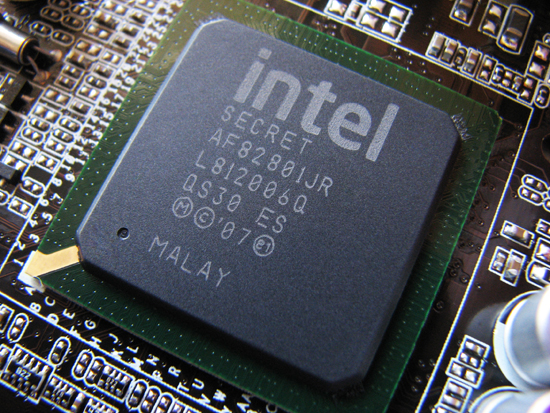 The Intel ICH10R Southbridge - trust us; there are no secrets in here. |
Motherboards based on P45 are also the first to include Intel's revised I/O Controller Hub, ICH10(R). When it comes to peripheral support, we were expecting something more than what ICH10 provides. The truth is ICH10R looks a lot like ICH9R. In fact, for 99% of users they might as well be one in the same. ICH10 (the non-RAID enabled variant) adds 2 more SATA ports for a total of 6, while ICH10R remains unchanged, with support for 6 ports, just as before. Among the more popular features, AHCI support and Intel's Matrix RAID Technology also make a comeback.
In light of the lack of change, P45's saving grace may be its relatively low price, assuming vendors decide to pass their savings on to the consumer. The latest channel information shows P45 chipset prices at around $40 USD in 1000-lot quantities, with the cost of X48 chipsets still hovering near the $70 USD mark. P45 appears to be more of a manufacturing optimization than anything else as the P45 Express chipset marks the first time that Intel has mass produced such a device using 65nm process technology. A side-by-side comparison with a P35 die reveals only slight differences in size and shape, not what we expected considering the die shrink from 90nm down to 65. We can only conclude that a significant portion of the new die has been dedicated to what will become G45, the upcoming chipset variant that will feature an X4500 integrated graphics GPU. That discussion will be postponed until a later date; for now let's take a closer look at what the ASUS P5Q3 Deluxe has to offer.
Board Layout and Features
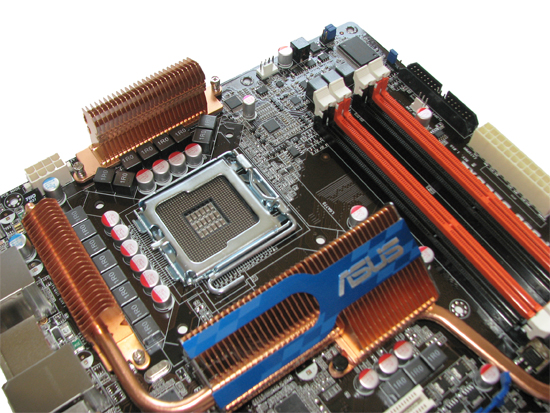
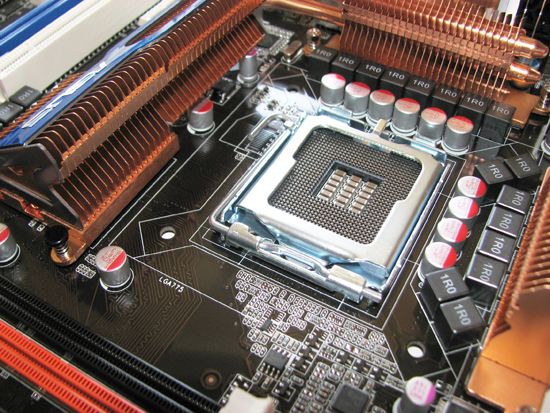
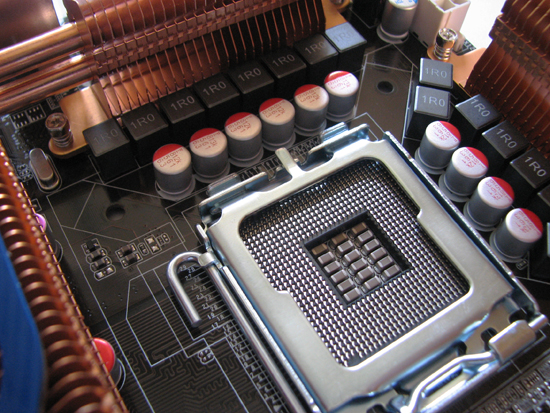
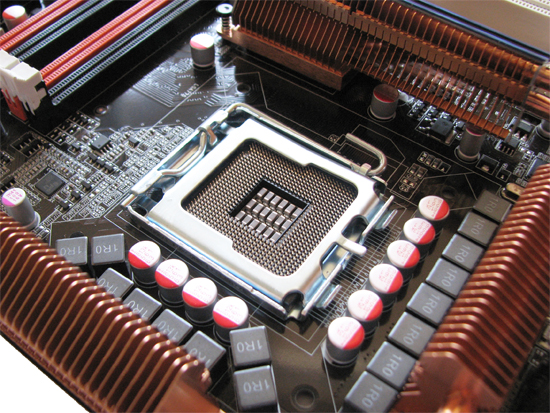
The P5Q3 may report the use of a 16-phase PWM but we know better. Although ASUS design engineers have added a lot of extra chokes and MOSFETS, the overall capacity of the power delivery circuit remains comparable to their competitors' more modest 8-phase designs. One thing's for certain, we can all agree that more phases do not necessarily make for a more stable power subsystem. Although we did not experience any problems with this particular solution we would rather see ASUS concentrate their efforts on designing an entirely new circuit based on a true 6-phase PWM.
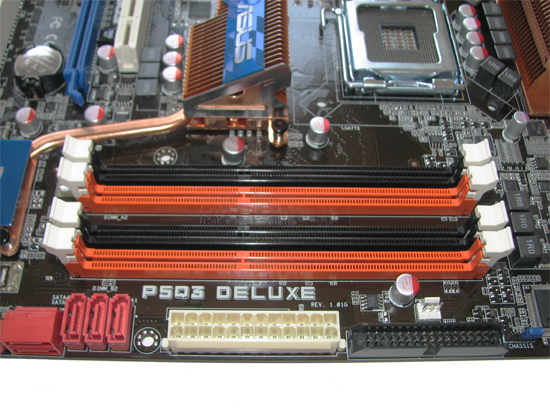
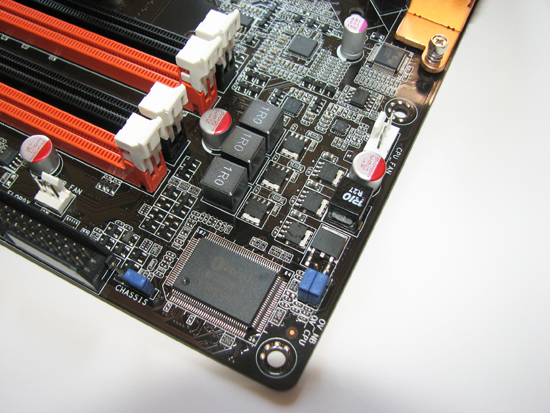
The DDR3 power circuit is a 3-phase design, just like the P5E3 Premium, and the board has no problems clocking memory to speeds of DDR3-2000 and higher. We recommend you place your modules in the orange slots first and populate the black slots only as needed. Because of the way DDR3 signals are terminated on the modules themselves, it is often possible to coax maximum speed from the system with the memory in this configuration.
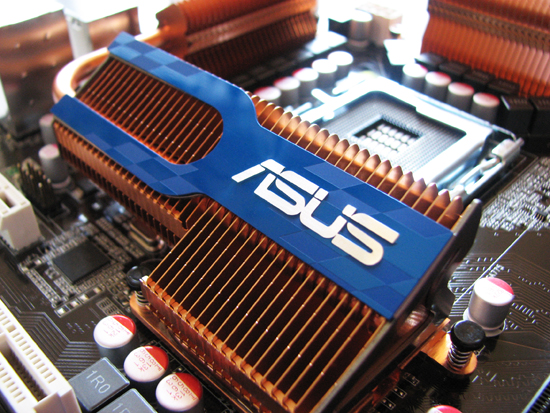
The all-copper heatsink is both functional and aesthetically pleasing. ASUS was also wise to include back plates for the portions of the cooler covering the power MOSFETs and mounting screws to tightly secure the assembly to the board.
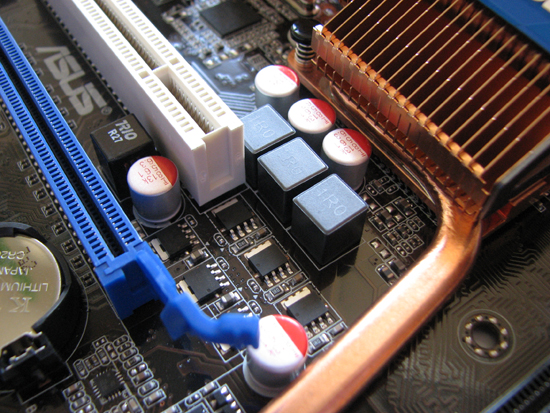
ASUS engineers have taken their MCH power delivery system one step further than before; the P5Q3 now features a 3-phase design whereas the P5E3 Premium used a 2-phase solution. Thanks to the relatively low power requirement of the MCH, active cooling is not necessary for any of these MOSFETs, although it could not hurt if you decided to customize your board by placing extra sinks on the hotter components.
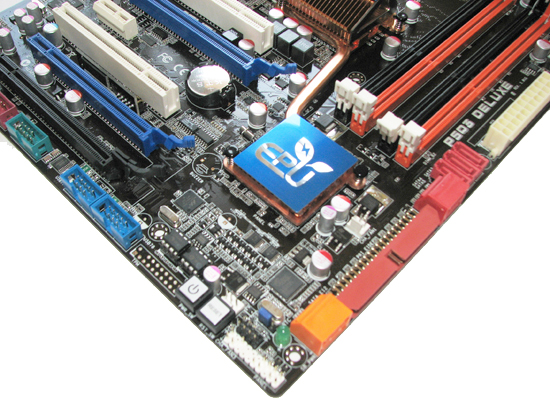
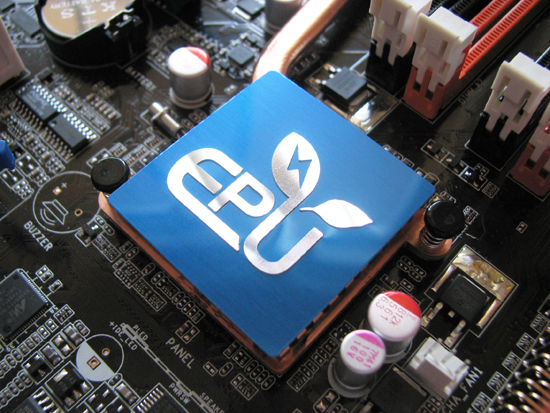
The five red SATA ports are electrically connected to the ICH10(R) Southbridge with the sixth present in eSATA form, located on the board's back panel. A JMicron JM363 host controller provides an additional two SATA ports (orange), capable of RAID 0, 1 and JBOD operation, as well as a single PATA port for legacy IDE hard disk or optical disc support. Integrated power and reset momentary tactile switches can been seen in the corner of the board. The lone green LED is the only indication that the board is powered - be sure to pay attention to the state of this light whenever removing or inserting any components.
The ICH10R is covered by a custom two-piece heatsink and is thermally coupled to the MCH and half the bank of CPU power MOSFETs via a single heatpipe. It would have made sense to include the other MOSFET cooler but the placement of the ATX12V+ power connector might have made this difficult. The cobalt blue cover is adorned with an artistic "EPU" logo and represents the incorporation of ASUS' Energy Processing Unit technology that seeks to maximize overall system power savings during periods of light CPU loading by selectively enabling and disabling power delivery phases for the most efficient operation possible. Our lab results show the savings to be small yet measurable.
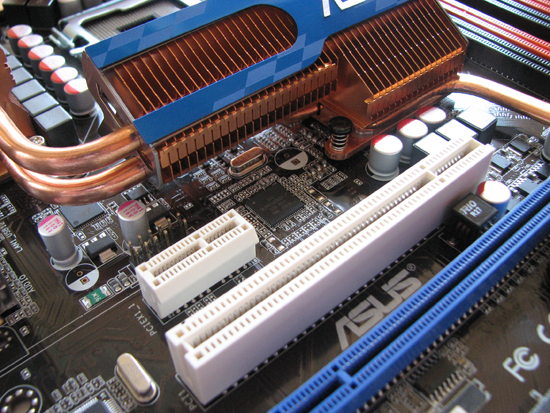
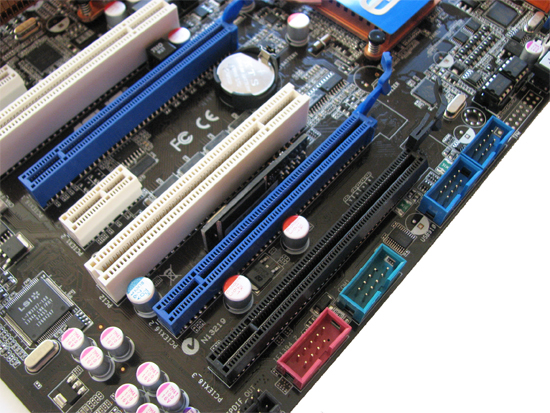
The P5Q3 Deluxe includes support for up to three PCIe x16 cards. The two blue slots are fully PCIe 2.0 compliant and hang off the P45 Northbridge. They can be configured for either 1x16 or 2x8 operation, depending on the number of cards installed. The bottom black slot is PCIe 1.x compatible only and is serviced by the ICH10R Southbridge. While the slot can mechanically seat x16 cards the maximum electrical connection is just x4 due to the lack of available lanes. For maximum performance, populate the blue slots before working with the last black one.
Two PCIe x1 slots (1.x compatible) and a pair of legacy PCI slots round out the board's expansion capabilities. Overall, we prefer the P5Q3 Deluxe expansion slot layout over that offered by the P5E3 Premium. Unlike the X48 board, this P45 board provides double spacing between the two primary PCIe 2.0 slots.
ASUS P5Q3 Deluxe (WiFi-AP@n) Specifications
| ASUS P5Q3 Deluxe / WiFi-AP@n | |
| Market Segment | Mainstream Performance - $229.00 (MSRP) |
| CPU Interface | Socket T (LGA775) |
| CPU Support | Any LGA775-based CPU, Core 2 Duo, Core 2 Extreme, or Core 2 Quad recommended, including next-generation 45nm CPU support |
| Chipset | Intel P45 Northbridge (MCH) with Fast Memory Access Technology and Intel ICH10R Southbridge |
| CPU Clock Multiplier | 6x ~ 11x, downward adjustable for Core 2, upward to 31x for Core 2 Extreme, including half-multiplier support for 45nm processors |
| Front Side Bus Speeds | Auto, 200 ~ 800 in 1MHz increments |
| System Bus Speeds | 1600 / 1333 / 1066 / 800 MHz and 2000 / 1800 MHz (OC) |
| DDR3 Memory Ratios | 1:1, 6:5, 5:4, 4:3, 3:2, 8:5, 5:3, and 2:1 (dependent upon strap selection) |
| FSB Strap | Auto, 200, 266, 333 and 400 |
| PCIe Speeds | Auto, 100MHz ~ 180MHz |
| PCI Speeds | Locked at 33.33MHz |
| DRAM Voltage | Auto, 1.50V ~ 2.78V in 0.02V increments, 1.50V (DDR3) standard |
| DRAM CLK/CMD Skew CA/CB | Auto, Manual (Advance/Delay 50ps ~ 350ps in 50ps increments) |
| DRAM Timing Control | Auto, Manual - 20 DRAM Timing Options (tCL, tRCD, tRP, tRAS, tRFC and 15 other sub-timings) |
| DRAM Static Read Control | Auto, Enabled, Disabled |
| DRAM Dynamic Write Control | Auto, Enabled, Disabled |
| Ai Clock Twister | Auto, Ligher, Light, Moderate, Strong, Stronger |
| Ai Transaction Booster | Auto, Manual |
| Common Performance Level | 1 ~ 31 (settings above 14 prevent POST) |
| CH A/B Phase Pull-In | Based on Memory Divider, All Phases Adjustable (Enabled/Disabled) |
| CPU Voltage | Auto, 1.10000 to 1.70000 in 0.00625V increments then to 2.1V w/OV jumper |
| CPU PLL Voltage | Auto, 1.50 ~ 2.78v in 0.02V increments, 1.50V standard |
| FSB Termination Voltage (VTT) | Auto, 1.20V to 1.50V in 0.02V increments, 1.20V (65nm CPU) or 1.10v (45nm CPU) standard |
| NorthBridge (NB) Voltage | Auto, 1.25V ~ 1.91V in 0.02V increments then to 2.21V w/OV jumper, 1.25v standard |
| SouthBridge (SB) Voltage | Auto, 1.05V ~ 1.20V in 0.15V increments, 1.05V standard |
| Clock Over-Charging Voltage | Auto, 0.70V ~ 1.00V in 0.10V increments, 0.80V standard |
| Load-Line Calibration | Auto, Normal, Performance |
| CPU GTL Voltage Reference | Auto, 0.370x ~ 0.760x in 0.005x increments, 0.630x standard (both dies) |
| NB GTL Voltage Reference | Auto, 0.61x ~ 0.67x in 0.06x increments, standard 0.67x |
| Memory Slots | Four 240-pin DDR3 DIMM Slots Dual-Channel Memory Architecture Regular Unbuffered, non-ECC DDR3 Memory to 8GB Total |
| Expansion Slots | 2 - PCIe 2.0 x16 (blue), Supports ATI CrossFire Technology @ 2x8 1 - PCIe (1.x) x16 (black) @ x4 or x1 mode only 2 - PCIe (1.x) x1 2 - PCI Slot 2.2 |
| Onboard SATA RAID | 6x SATA 3.0Gbps Ports - ICH10R (Intel Matrix RAID 0, 1, 5 and 10) |
| Onboard IDE/Additional SATA | Jmicron JMB363 PATA Controller (up to 2 UDMA 133/100/66 devices) 1x External eSATA ports - RAID 0, 1 and JBOD |
| Onboard USB 2.0/IEEE-1394 | 10 USB 2.0 Ports - (6) I/O Panel - (4) via Headers 2x Agere/LSI L-FW3227-100 IEEE-1394a Ports - (1) I/O Panel, (1) via Header |
| Onboard LAN (with Teaming) | 1x Marvell 88E8056 PCI Express Gigabit Ethernet controller 1x Marvel 88E8001 PCI Gigabit Ethernal controller |
| Wireless LAN (optional) | ASUS WiFi-AP@n (USB-based), 300Mbps Draft Wireless-N (Wireless-G/Wireless-B compatable), Software Access Point mode |
| Onboard Audio | ADI AD2000BX 8-channel HD Audio CODEC |
| Power Connectors | ATX 24-pin, 8-pin EATX 12V |
| I/O Panel | 1 x PS/2 Keyboard/Mouse 2 x SPDIF - (1) Optical Out, (1) Coaxial Out 1 x External eSATA 2 x IEEE-1394a - (1) back panel, (1) header 2 x RJ-45 (LAN) 6 x USB 2.0/1.1 8 channel Audio I/O 2 x WiFi-Ap@n antenna jacks (optional) |
| Fan Headers | 6 - (1) CPU, (1) Power, (4) Chassis |
| BIOS Revision | 0129 (pre-release) |
| Board Revision | 1.03G |
The ASUS P5Q3 Deluxe is strikingly similar to the ASUS P5E3 Premium in both layout and specification. Worth noting is that the P5Q3 Deluxe will be bundled for sale with ASUS' WiFi-AP@n wireless Draft-N controller. We really like the idea of including useful features such as these onboard but would really like to see ASUS ditch the USB-connect interface for something a little more modern, like a PCI Express x1 link.
An Analog Devices AD2000BX 8-channel HD CODEC provides onboard audio. Although we do not have much information about this new controller as of yet we can tell you that our initial listening impressions leave us feeling that It's a notch above the ADI1988B Audio CODEC that ASUS has been extensively utilizing for the past two years.
The crowd of readers that constantly complain about the lack of Firewire-800 support will have no reason to change their tune - up to two 1394a ports, one on the back panel and one via an optional header, are provide by a single Agere/LSI L-FW3227-100 IEEE 1394a Firewire-400 controller. When asked why no current motherboard supported the newer Firewire-800 standard, ASUS representatives commented that the cost of the controller was excessive when first introduced but admitted that the price should have substantially dropped over the years and resolved to see what could be done for future boards.
The P5Q3 also includes the latest and greatest Express Gate module, which allows quick pre-boot access to digital content stored on a USB drive or other attached media, near instant access to the internet and communications programs like Skype, and the ability to play simple games regardless of the OS installed (including the lack of any main system drive). This environment is built using a highly-optimized, low footprint Linux kernel and is upgradable - meaning as new features are released they can be added to the system at no additional cost.
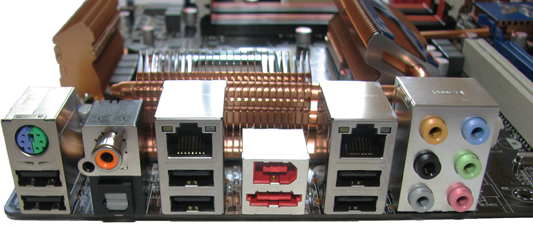
The back panel contains a pretty standard array of connection I/O ports. There is a PS/2 port capable of supporting either a single keyboard or mouse, two SPDIF audio ports (one digital Coax, one optical), analog speakers outputs including line-in, six USB 2.0 ports, two RJ-45 1Gbps Ethernet ports, one eSATA port, and a single 1394a (Firewire-400) port.
Test System Configuration & General System Performance (PCMark Vantage)
| Test System Configurations | |
| Motherboards |
ASUS Striker II Extreme (NVIDIA nForce 790i-Ultra SPP and 570 MCP)
EVGA NVIDIA nForce 780i SLI MSI PN7 Platinum (NVIDIA nForce 750i SPP) ASUS P5E3 Premium (Intel X48 Experss MCH and ICH9R) ASUS P5K3 Deluxe (Intel P35 Experss MCH and ICH9R) ASUS P5Q3 Deluxe (Intel P45 Express MCH and ICH10R) |
| Processors |
Intel Core 2 Duo E8500 (ES)
Dual-core, 3.16GHz, 6MB Unified L2 Cache, 9.5x Multiplier, 1333 FSB Intel Core 2 Extreme QX9770 (ES) Quad-core, 3.20GHz, 2x6MB Unified L2 Cache, 8.0x Multiplier, 1600 FSB |
| Memory |
4x1GB OCZ DDR3 PC3-14400 Platinum Edition
4x1GB OCZ DDR2 PC2-8000 Platinum Extreme Edition |
| Graphics Card | ASUS EN8800GTS TOP 512MB (G92) |
| Cooling | D-tek FuZion CPU block, EK-FC88 GT/GTS full coverage GPU blocks, ThermoChill PA120.3 radiator, 3x SUNON KDE1212PMB3-6A 120x38mm fans, Laing D5 pump, 1/2" ID (3/4" OD) Tygon tubing |
| Power Supply | OCZ EvoStream 600W Modular PSU |
| Hard Drive | Western Digital WD250YS, 250GB, 7200RPM, SATA 3Gb/s, 16MB buffer |
| Video Driver | NVIDIA 169.25 (latest WHQL) |
| Operating System | Windows Vista Ultimate (x64) SP1 with DirectX 10.1 |
In order to compare the relative performance of base gaming rigs built using each chipset, we assembled identically configured systems in which the only component that was varied was the motherboard. All other components - including the CPU, memory modules (whenever possible), PSU, and graphics card - were simply transferred from one system to the next. An ASUS Striker II Extreme was used for the 790i base, an ASUS P5E3 Premium represented our choice in X48 motherboards, the ASUS P5K3 Deluxe for the P35 and the new contender, the ASUS P5Q3 Deluxe, provided the platform for testing the P45 chipset.
System power was measured at the wall, and thus our reported results do not make use of any power efficiency correction factor that would be helpful in more accurate relating actual power draw to typically system power consumption. This is an unimportant detail as these findings are merely intended to provide a means for differentiating one chipset from the next.
Data was collected after booting each system and allowing sufficient time for all OS activity to die down (about 7 minutes) and after total system load was noted to have stabilized for at least 30 seconds while stressing the CPU using a multi-instancing, 64-bit build of Prime95. "Small FFTs" were tested in order to create maximum CPU load while the "Blend" option was used to stress the memory subsystem (and thus the MCH).
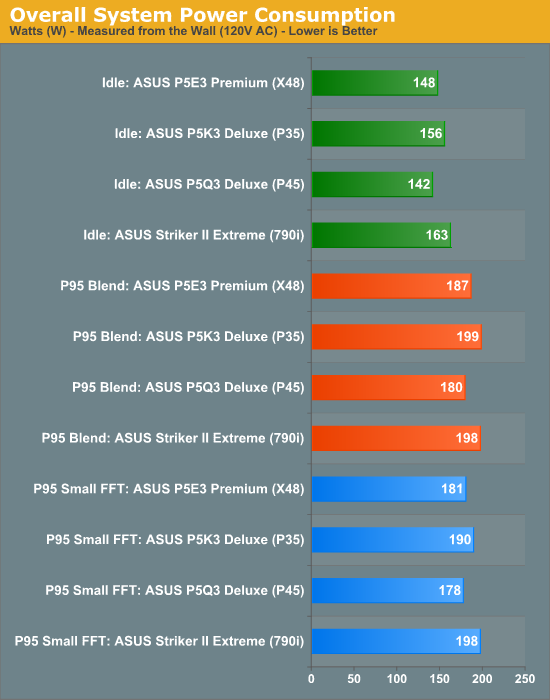
At idle the P5Q3 Deluxe (P45) shows a savings of about 6W on average beyond the already low power usage of our X48 test system. Of these results, perhaps the power consumption figures for the P35 board were the most surprising - despite running hotter even the X48 system showed better efficiency than the older P35 chipset. The Striker II Extreme, with the NVIDIA nForce 790i-Ultra chipset, ranked a distant fourth, consuming 7W more than P35 and proving once again that power efficiency often takes a back seat to performance when dealing with high-end systems.
Loading each system by running Prime95 in "Small FFT" mode results in near identical power consumption figures for the P45 and X48 systems. The NVIDIA 790i-based board and the P5K3 (P35) trailed the pack, drawing over 10% more power clock-for-clock than either board featuring a 4-series Intel chipset.
Finally, "Blend" mode shows the P45 board providing quite interesting results - our wall power meter registered little difference between this mode and "Small FFTs". This suggests that the P45 chipset's prefetch algorithms are tuned for exceptionally low power operation even when memory intensive applications call for heavy access to data stored in main system memory. X48 is a stark contrast to this as programs that rely on heavy traffic to system memory consistently result in higher system power consumption.
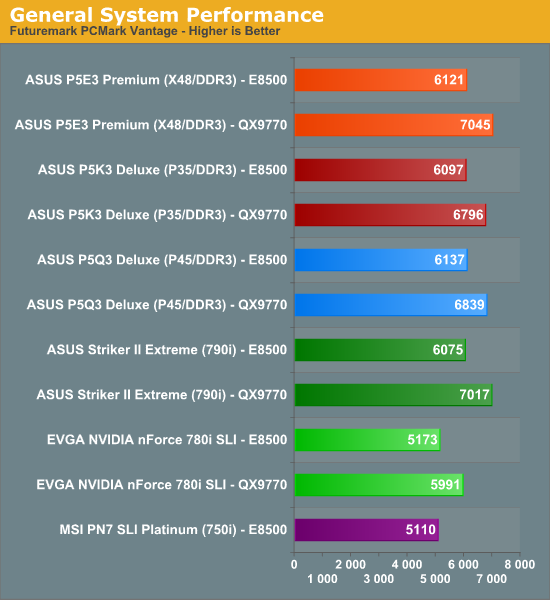
We ran a just enough of PCMark Vantage as necessary for the generation of proper total system score. As a rule of thumb, DDR3 systems generally out-score their DDR2 counterparts by at least 1000 PCMarks, regardless of tuning. When placed side-by-side P35, P45 and X48 look a lot like NVIDIA's 790i-Ultra when it comes to measuring overall system productivity.
One of the useful aspects of PCMark Vantage is that these figures can serve as baseline results for comparing our test systems to yours at home. Try to match your components as closely as possible to ours, with the exception of your motherboard, when contrasting your results with those shown here.
Memory Performance (Read, Write, Copy and Access Latency)
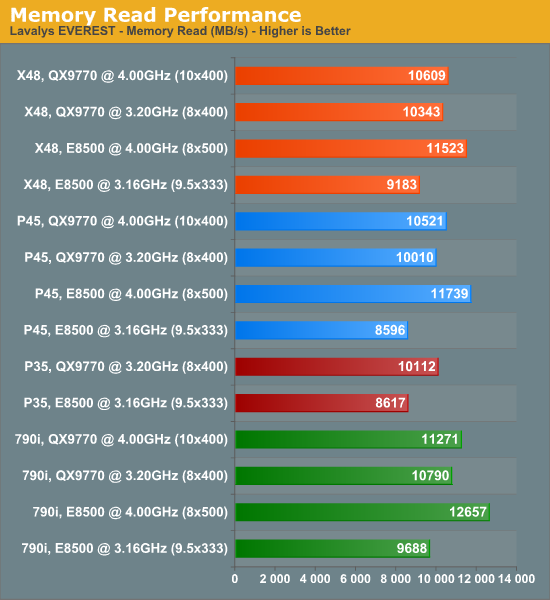
Our memory read performance results indicate that P45 is a strong performer moderate to high bus speeds when compared to X48. The X48 chipset holds a commanding lead until an FSB of about 450MHz wherein P45 pulls ahead and takes the gold. The combination of higher bus speeds and high CPU frequencies seems to magnify the P45 performance advantage when compared to X48. Clock-for-clock the 790i-Ultra chipset clobbers both P45 and X48, at least when it comes to raw memory read bandwidth.
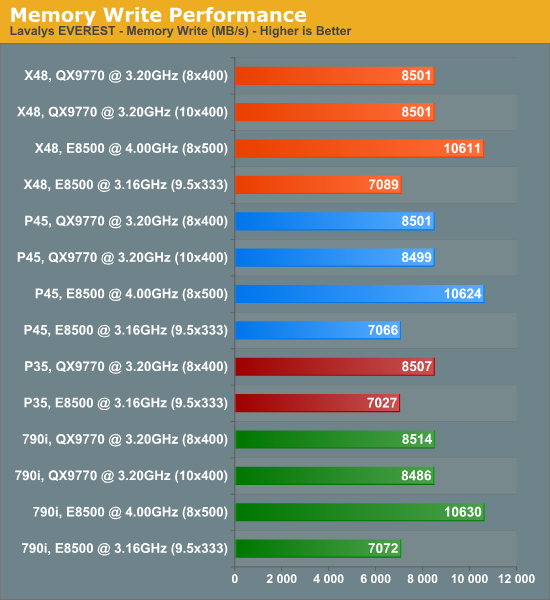
Seeing as how memory write performance scales almost perfectly with FSB and little else, there were no surprises when it came testing each memory controller's ability to write to system memory. Our results were well within the margin of error needed to quote each controller as being equal when it came to handling sustained memory writes.
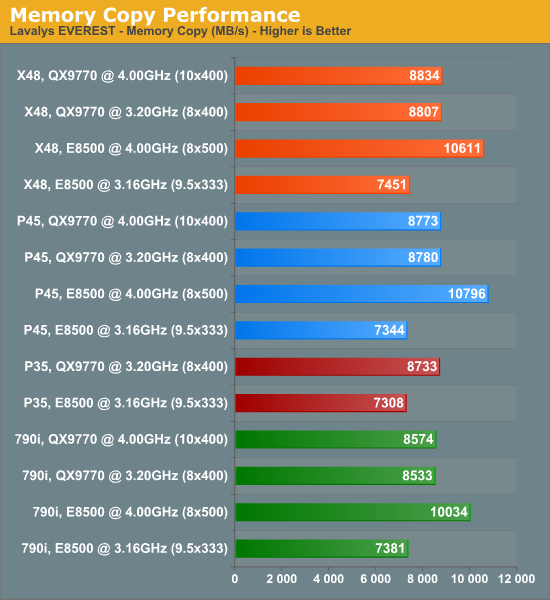
Once again X48 puts on a superior performance at low to moderate bus speeds but falls behind P45 when pushing towards 500MHz FSB. Those that are looking to purchase low-multiplier CPUs that will demand high bus speeds in order to achieve maximum core frequencies will be wise to consider a P45-based board. Interestingly, the 790i-Ultra board, the Striker II Extreme, shows problems keeping up with Intel when it comes to memory copy performance. Intel's heavy investment in prefetcher algorithm tuning has definitely paid dividends as Intel chipsets consistently out-perform NVIDIA chipsets when it comes to effectively simultaneously balancing memory read and write performance.
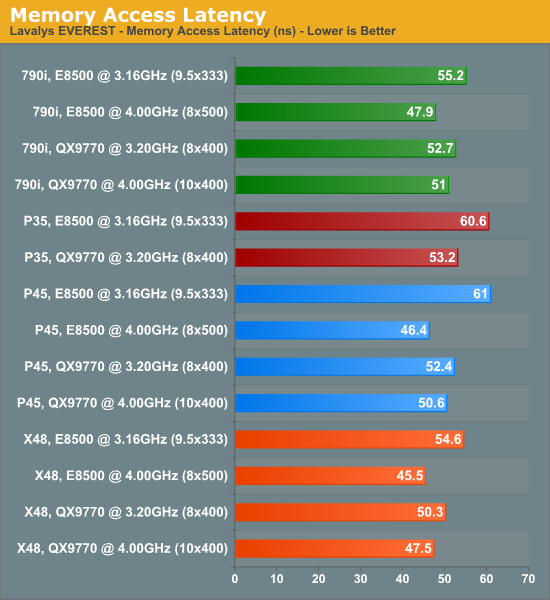
Depending on where you plan on running your system each of the three chipsets performs differently when compared to the others. However, if asked we would give the nod to the Intel X48 chipset for consistently putting up the lowest access latency times, a fact which sometimes provides a significant performance advantage when running memory-sensitive benchmarks.
General 3D Graphics Performance (3DMark06, 3DMark Vantage)
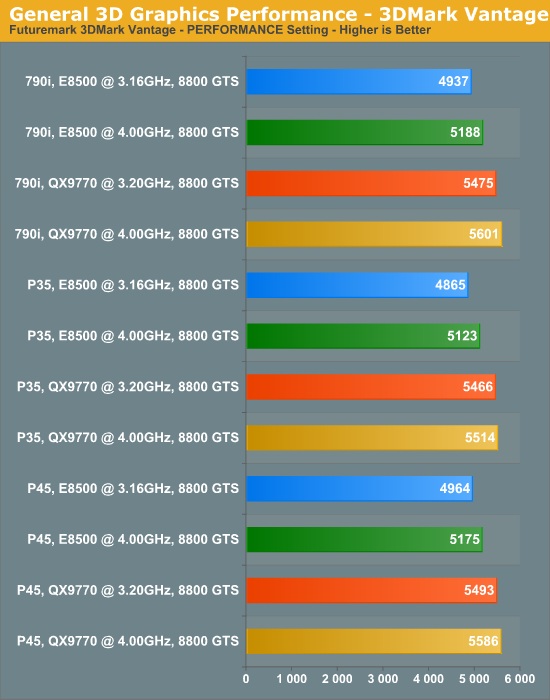
Our first general 3D graphics performance results are from Futuremark 3DMark Vantage Professional Edition. We used the "Performance" preset for all of our tests and achieved our highest score of P5586 using 8800 GTS 512MB (G92) GPU stock clocks on our ASUS EN8800GTS TOP card with an Intel QX9770 at 4.0GHz (10x400). We are in the process of testing all of our X48 and 790i boards using this new benchmarking suite and will have a host of results to compare to P45 as soon as we are finished collecting data.
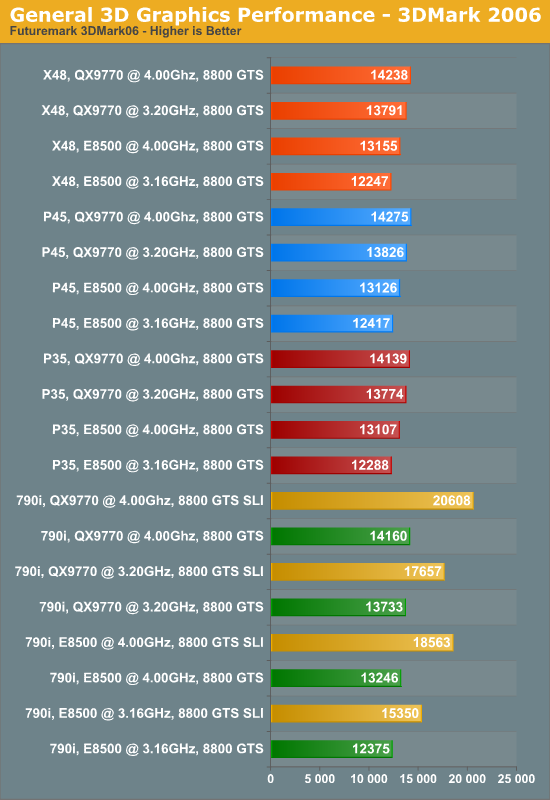
The ASUS P5Q3 Deluxe has no problems holding its own against its bigger brother, the P5E3 Premium. Single card performance using an ASUS EN8800GTS TOP card is nearly identical between the three boards. Huge gains can be seen moving to an SLI setup with the ASUS Striker II Extreme. We will be showcasing P45 and X48 AMD/ATI CrossFire(X) performance using both one and two 3870X2 cards soon.
Gaming Performance: UT3 and COH
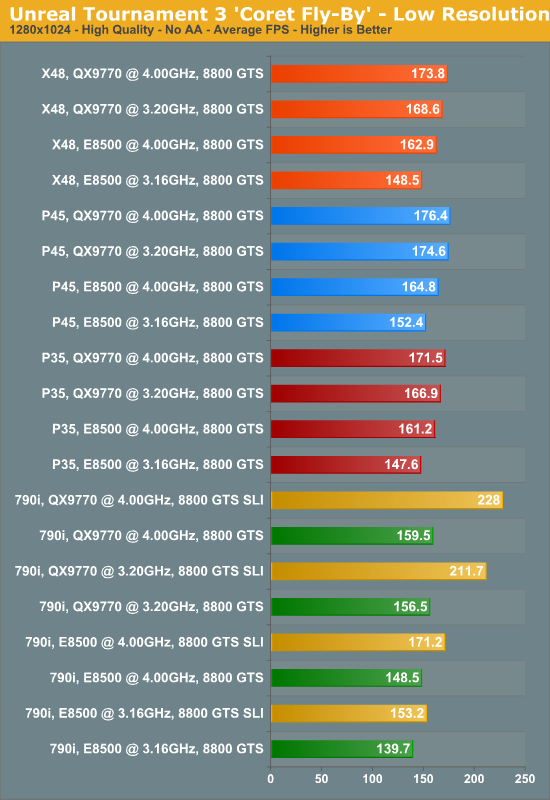
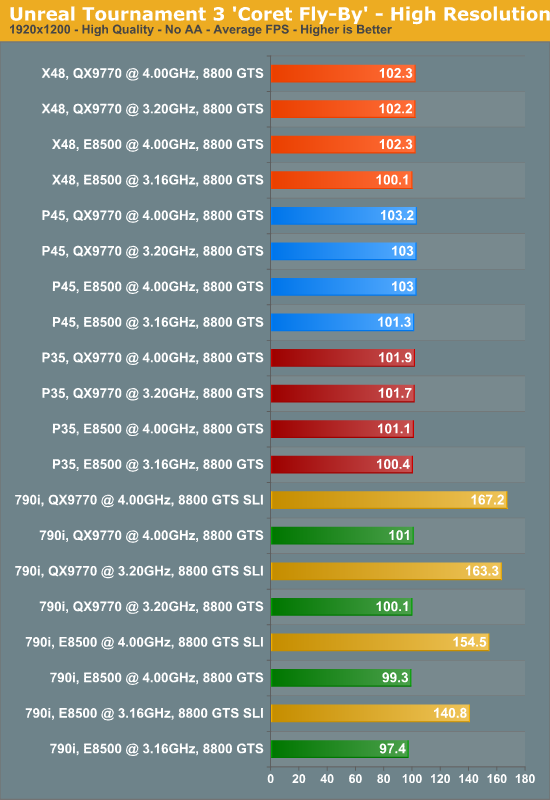
We were actually able to measure a slight performance advantage for P45 when benching Unreal Tournament 3 (UT3). Our best results with this game have always come from Intel-based boards, as UT3 is extremely responsive to low memory latencies when tuned properly. Without a doubt, for those that plan on purchasing no more than one video card for the purposes of playing UT3, this is a great board. Of course, the results become somewhat muddled at higher resolutions due to GPU limitations with each board performing similarly at 1920x1200 pixels. At this point, only another GPU can provide relief and higher frame rates.
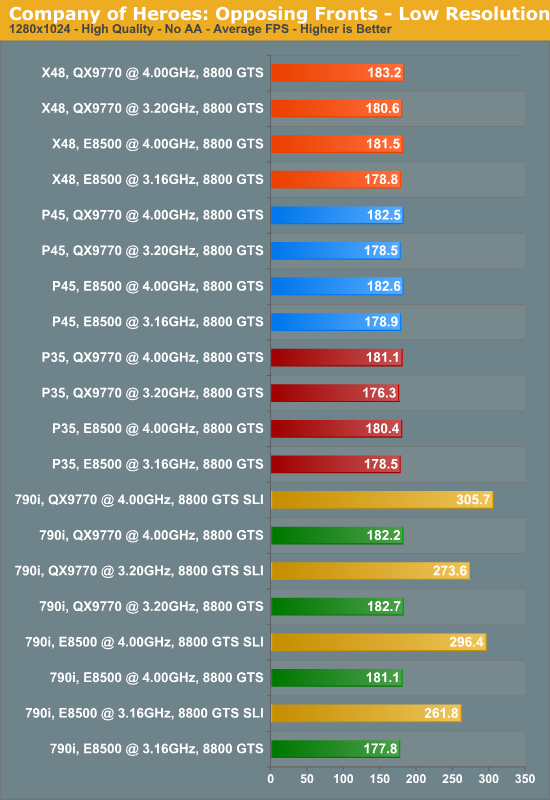
Performance of COH: Opposing Fronts at low resolutions has a lot to do with raw CPU muscle, which is why each setup performs nearly the same. At these frame rates, everything is smooth as silk. Enabling AA is good way to improve the image quality when dealing with such a surplus of power.
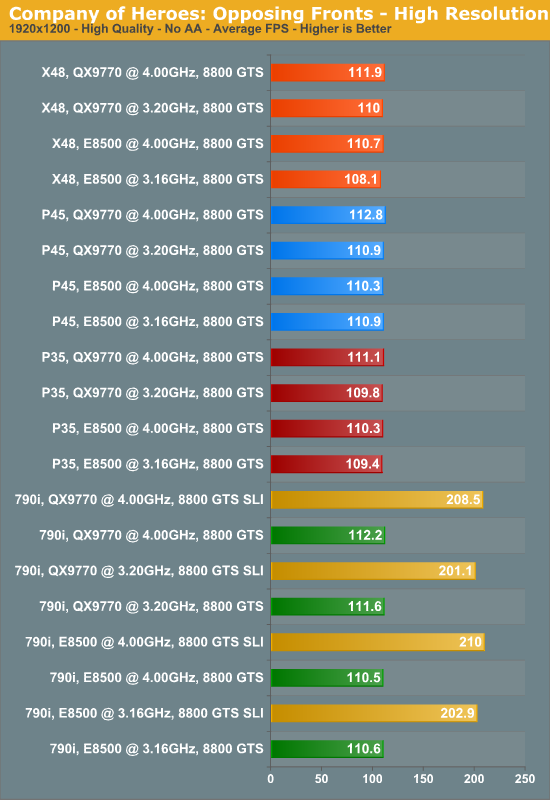
Even at the higher resolution (1920x1200) Company of Heroes is still entirely playable with just a single 8800 GTS 512MB (G92) GPU. SLI scaling with this game is nearly perfect; adding a second GPU nearly doubled our measured average frame rate from around 110FPS to nearly 210FPS with a 45nm quad-core CPU.
Just a Taste of Early Overclocking Results
Because our ASUS P5Q3 Deluxe motherboard was built using early P45 silicon (revision A2), we believe it to be entirely appropriate to reserve final judgment of the board's overclockability until such time as retail products are ready for release. With that being said, we also want to bring you an early look at our first attempts at overclocking the P5Q3 Deluxe.
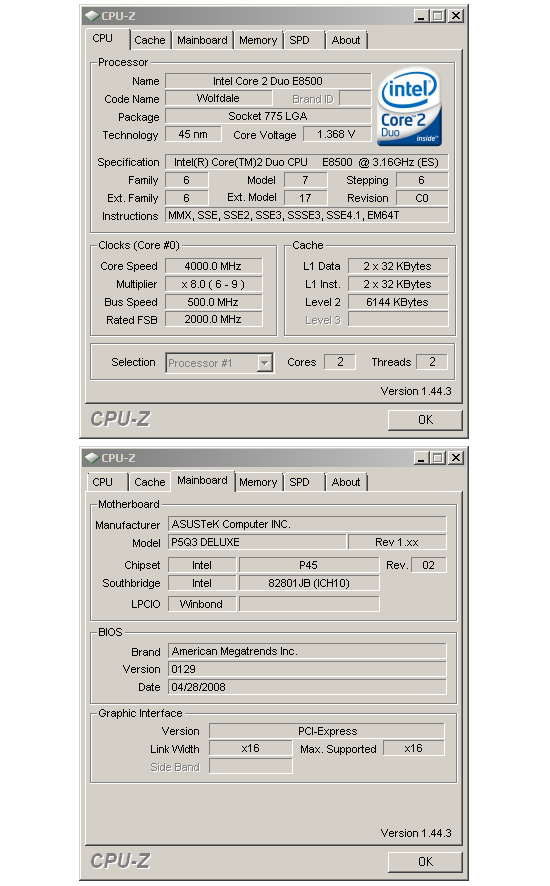
Achieving 4.0GHz with a dual-core Core2 E8500 was breeze thanks to our ASUS P5Q3 Deluxe.
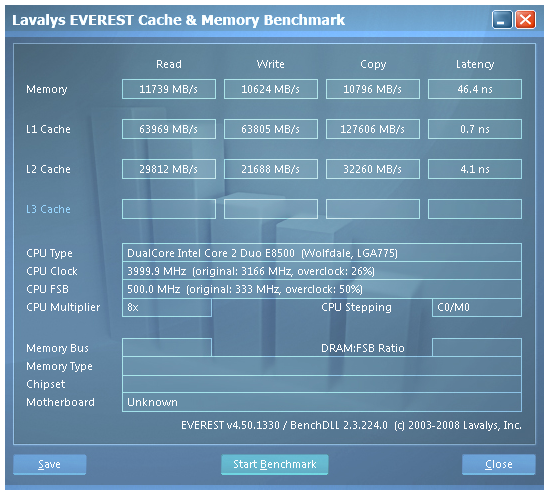
Lavalys EVEREST had trouble identifying our motherboard, but the results are 100% accurate.
Using an E8500 we were able to push to 500FSB, albeit with more vMCH than we expected - nearly 1.5V was needed for sustained stability. This is precisely one of the reasons that we would like to withhold our final opinions on the overclocking merits of this board. We know there is a new P45 silicon spin in the works (revision A3) and thermal and power characteristics generally improve as each new product's process improves. In the meantime, our results at least offer us hope that P45 has the potential to outshine even P35, which has proven to be an amazingly overclockable chipset.
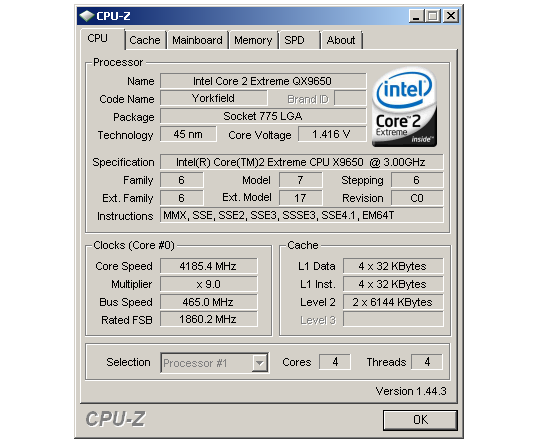
Our maximum FSB overclock with a tRD (Static Read Delay) of 7 using our QX9650 was great considering our relative inexperience working with P45.
We decide to see how far we could push the board at a tRD of 7 (about 465FSB). Going any higher required a switch to a tRD of 8, leaving valuable memory performance on the table whilst only giving us a couple more megahertz before our quad-core CPU ran out of steam. We are more than happy with this result though as 465FSB is still the sweet spot for a lot of boards when using anything with more than two cores.
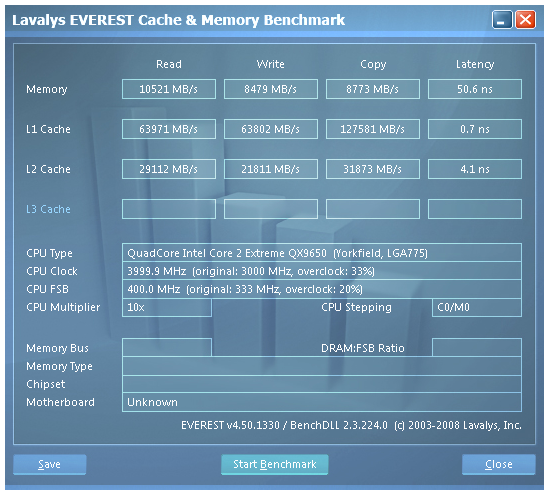
Latencies around 50ns and read scores well above 10GB/s are a real treat when playing with a quad-core CPU.
Our preferred operating point, 10x400, is looking good with P45. Given this, it might be hard to justify the extra expense of an X48 board if all we plan on doing is light gaming with the best CPU we can afford. Later, if we decide we need more 3D graphics power, we can always drop in another GPU as long as we're smart about it and start with a CrossFire-ready graphics card.
Initial Thoughts and Recommendations
The ASUS P5Q3 Deluxe definitely has all the makings of one of our favorite boards: a quality design with quality components, an elegant layout with plenty of room for two full-sized graphics cards, DDR3 memory for maximum performance, a robust stock cooling system, and enough onboard features to choke a horse. Although it certainly does not look like it will be our top pick for absolute maximum overclocking or benching, we can hardly fault ASUS. After all, the P5Q3 Deluxe screams mainstream value. ASUS could have a real winner on their hands here as long as they are smart about it and price this board appropriately.
We're not going to lie, though. If you already own an X38 or X48 motherboard there is not much point in moving over to a P45 board. For those of you out there that are still running on last year's P35 and looking for something new, look no further. A move to P45 should be simple and graphics performance should improve thanks to support for the PCIe 2.0 specification and the new 2x8 lane configuration mode. Also, unlike P35, P45 has been tuned with 45nm CPU performance in mind.
Not to rain on Intel's parade, but it's also important to look at the bigger picture. Many users are already running P35 or X38/X48 motherboards, and outside of bragging rights or for new system builds, there's no reason for such users to look at P45 boards right now. We do know that Nehalem will completely change the Intel platform in the next 6-8 months, and if you're already running a quad-core CPU you can almost certainly stave off upgrading motherboards and memory for a while longer. Also keep in mind that SLI support remains exclusive to NVIDIA chipsets (or boards with NVIDIA nForce 100/200 chips like Skulltrail); P45 looks to be a great option for affordable CrossFire systems, but users that prefer SLI are left with the choice of running a GX2 or using an NVIDIA chipset motherboard.
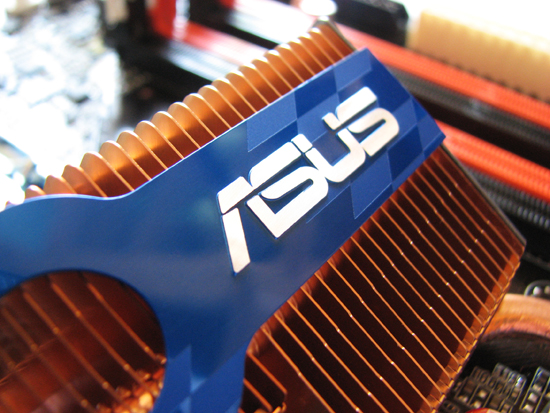
For those of you that are still hesitant to make the move to DDR3, have no fear. ASUS also plans to introduce a DDR2-variant dubbed the P5Q Deluxe that promises to bring nearly all of the same features save support for DDR3 system memory. We plan on bringing you an early look at this board as well so keep your eyes peeled for even more P45 lovin'.
We also expect to have more boards from GIGABYTE, abit, DFI, MSI, and Foxconn in our hands before the end of the month. With many new motherboards due to arrive in the coming months there's sure to be fierce competition for your hard-earned money. Without a doubt, these companies will be working harder than ever to convince you why their product is the very best. In the end, the consumer will be the winner.

